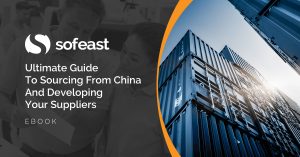Let’s say you have done your homework, and you have decided that you should source from China/Vietnam/an other emerging Asian country. Now, what are the steps? Is there something you really don’t want to forget?
I got this question several times, so I prepared this checklist for importers:
Manufacturing your products in China / low-cost Asia? Here’s a checklist for importers
Here are the basics you should be on top of before importing products from China/low-cost Asia. If you can follow all of these tips then you’ll be in a far stronger position where your project will run more smoothly.
Describe the product
- Write down precise product specifications
Identify and pre-qualify supplier(s)
- List potential suppliers that offer the right kind of product
- Communicate your standard terms (about payment, QC…)
- Ask a rough quotation
- Do a background check on the supplier and an audit of the factory
Share product information with potential supplier(s)
- Ask the supplier to sign and chop an enforceable NDA
- Share product specs with supplier(s)
- Send a sample to supplier(s), if applicable
- Get feedback about product specs
Develop special tooling/molds with supplier(s), if necessary
- Find a price agreement
- Get a development agreement signed and chopped by the supplier
- If necessary, wire money
Develop samples with supplier(s) [for a new product]
- Supplier sends 1st sample
- Client comments about 1st samples
- If necessary, supplier sends more samples
- Approval of golden sample
- Comments for production
Develop samples with supplier(s) [for a new labeling or packing]
- Supplier sends 1st sample
- Client comments about 1st samples
- If necessary, supplier sends more samples
- Approval of golden sample
- Comments for production
Finalize product specs
- Confirm with supplier that product specs are correct
Issue PO, confirm 1 supplier
- Select 1 supplier
- Make the product spec sheet an exhibit of the purchase order
Authorize the supplier to start production
- Get a manufacturing agreement signed and chopped by the supplier
- Launch the payment process (transfer of deposit / opening of letter of credit)
- Remind the supplier to book the materials/components immediately
Comment on production samples
- Supplier sends samples taken from mass production
- Comment on samples
- If necessary, supplier sends samples again
Inspection/testing during production
- Share PO & share product specs with inspection firm/staff
- Get an estimate of the price/time necessary, and confirm
- Tell supplier about inspection plans
- Supplier proposes timing of inspection
- Get report & give feedback to supplier
Book shipment with a forwarder
- Get quotes and compare them
- Confirm a quote
- Start tracking shipment with forwarder
Approve quality before shipment
- Share PO & share product specs with inspection firm/staff
- Get an estimate of the price/time necessary, and confirm
- Tell supplier about inspection plans
- Supplier proposes timing of inspection
- Get report & give feedback to supplier
- If necessary, proceed to re-inspection and issue a debit note to supplier
Shipment
- Forwarder advises closing date
- Authorize shipment
- Forwarder confirms the products were made available in time
- Forwarder confirms the products were shipped out
- Supplier sends a copy of the documents
- Confirm that the documents are all correct
Final payment
- Check the quantity of shipped products
- If payment by bank wire: transfer the balance
- Supplier sends all original documents
- Confirm receipt of all original documents
Customs clearance
- Forwarder/agent applies for clearance
- Payment of import duties
Domestic transport
- Arrange domestic transport
- Confirm receipt of products
Warehousing
- Arrange sufficient manpower and space
QC on incoming products
- Share PO & share product specs with internal QC staff
- QC service checks conformity & quality
- If necessary, give feedback to supplier and inspectors
I tried to cover 95% of situations for importers of consumer goods and simple industrial products… Anybody have anything important to add to this checklist for importers?
Ultimate Guide To Sourcing From China And Developing Your Suppliers [eBook]
This FREE eBook starts from the beginning, discussing whether you need to hire a sourcing agent, and follows the sourcing process right through to developing a trusted supplier’s quality and productivity.
There are 15 chapters over 80+ pages to explore, providing exhaustive guidance on the entire sourcing and supplier development process from start to finish, including:
- Identifying suppliers,
- Negotiations,
- Quality inspections,
- Developing Chinese suppliers,
- Improving factory quality and productivity,
- and much more…



Good post. I think you’ve covered most of the important things one should do when sourcing from China, but I would also include a factory visit or audit of the potential suppliers after you’ve identified and pre-qualified them. The least you should do is ask them for their business license and have it verified.
Rodrigo,
Thanks a lot for the suggestion. I just added a checkpoint about it.
I don’t know how I forgot about this one 😉
Well thought out list! I would like to offer a sub-list for the section on supplier selection.
The single most important factor in determining the success or failure of your sourcing program will be finding the right supplier. It sounds obvious, but making apples-to-apples comparisons of vendors at a national level can be daunting.
Step One “Defining”
The “right supplier” is unique to each buyer. Force yourself to list all the desired attributes and rank them. Beyond the holy trinity of price/quality/leadtime also think of attributes like location (do they need to be near a certain port or in area where you have other vendors), Capacity, Service Attitude, Language, Intellectual Property, Ownership, Equipment, Export Experience and so on.
Step Two “Measuring”
Initial research generates a list of 50-100 potential suppliers using web directories like http://www.GlobalSources.com, LinkedIn contact and industry/trade show directories.
1. Assume the vendor is a middleman until proven otherwise, not the other way around.
2. Avoid factories that refuse to list the name or location of the production facility- they probably don’t own the PRC factory and are a middleman of some sort.
3. Focus on those factories that can clearly show production experience with your particular product or production method.
4. Be aware that polished English skills do not reflect production skills. Often the most polished websites are set up by trading companies.
Review the 50-100 candidates’ websites and brochures against client’s desired attribute list (but hold of on price until later) and narrow the field down to 15 to 20 candidates. At this point, “first contact” is initiated in the follow ways:
1. Send an e-mail to ask for a quote.
2. Are samples available? If they don’t have samples readily available, they probably don’t deal in your product on a regular basis.
3. Granted the sales team will be the most polished in terms of English skills, but how is their understanding of your basic requests? If you ask for information on a red umbrella and get sent a sample of a blue shoe, you are going to have problems with communication down the road!
4. Confirm the actual production location and ask for ownership papers of the factory. Be explicit that the production location may be audited and that this location cannot be changed w/out approval of buyer. (You would be surprised at the number of middlemen who will take the buyer on a visit of a factory only to change the location to a less expensive and poorer quality option after the buyer leaves)
The above research should narrow the field down to about 5 highly qualified candidates. At this stage, Quality Auditors are engaged for a few hundred USA to verify the factory has a sufficient quality control system in place to make the desired product. It is also wise to conduct due diligence to confirm the factory has a good reputation, no legal problems and is sound financially. In other words, verify they are not going to disappear with your deposit and will be around long enough to complete your order!
Due to the massive number of trading companies and aggressive China sales staff who will say almost anything to get your business, visiting the production line in form of an audit is the only way to confirm the real situation.
Based on the results of the factory visits, the next phase is sampling, trial order or even Purchase Order placement with the top vendor or two.
Regards,
Mike Bellamy
Advisory Board Member & Featured Blogger at the not-for-profit China Sourcing Information Center (www.ChinaSourcingInfo.org)
Author, “The Essential Reference Guide to China Sourcing” (chinasourcinginfo.org/book/)
Thanks Mike, this is excellent advice!
And even when the whole list is checked, you need to go on checking and verifying quality and delays. I had worked with a supplier for 4 years before without any problem. And he delivered my customer’s order 4 months late. I know it is my fault : I should have check during the whole processus.
So never think you’re done with your suppliers. A supplier is a long-term relationship, which imply not to rely on previous assertions.
Fortunately, I was able to find an alternative solution for my customer, and I do not make this mistake again.
Antoine,
You are right, it’s not just a checklist for a first order. Buyers have to be hands-on in the production process.
excellent advice. Thanks